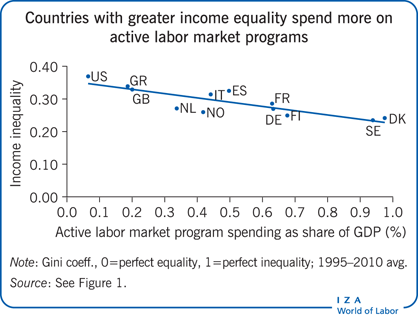Elevator pitch
Active labor market programs continue to receive high priority in wealthy countries despite the fact that the benefits appear small relative to the costs. This apparent discrepancy suggests that the programs may have a broader purpose than simply increasing employment—for instance, preventing anti-social behavior such as crime. Indeed, recent evidence shows that participation in active labor market programs reduces crime among unemployed young men. The existence of such effects could explain why it is the income-redistributing countries with greater income equality that spend the most on active labor market programs.

Key findings
Pros
Participating in an active labor market program reduces the propensity of unemployed young men to commit crime.
Program participation leaves less time for other activities, including criminal activities.
The effects might be long-lasting, since the programs seem to change the lifestyles of participants.
Long-lasting scars from unemployment—expressed through criminal activity—might be lessened by a well-designed active labor market policy.
While unemployment shocks cannot be avoided, active labor market programs might constitute a reasonable second best to employment for less fortunate young people.
Cons
Active labor market programs are expensive, and the intended benefits of reducing unemployment are lower than the costs.
Direct measures to reduce crime are likely to be more effective than tackling crime indirectly through active labor market programs.
While good active labor market programs enhance crime prevention, they tend to reduce the threat effect (people leaving unemployment in order to avoid participation in the programs).
Good programs can have a lock-in effect that delays reemployment.
Participating in active labor market programs, by leaving less time for job search, could reduce the effect of unemployment on wages and result in higher equilibrium unemployment.